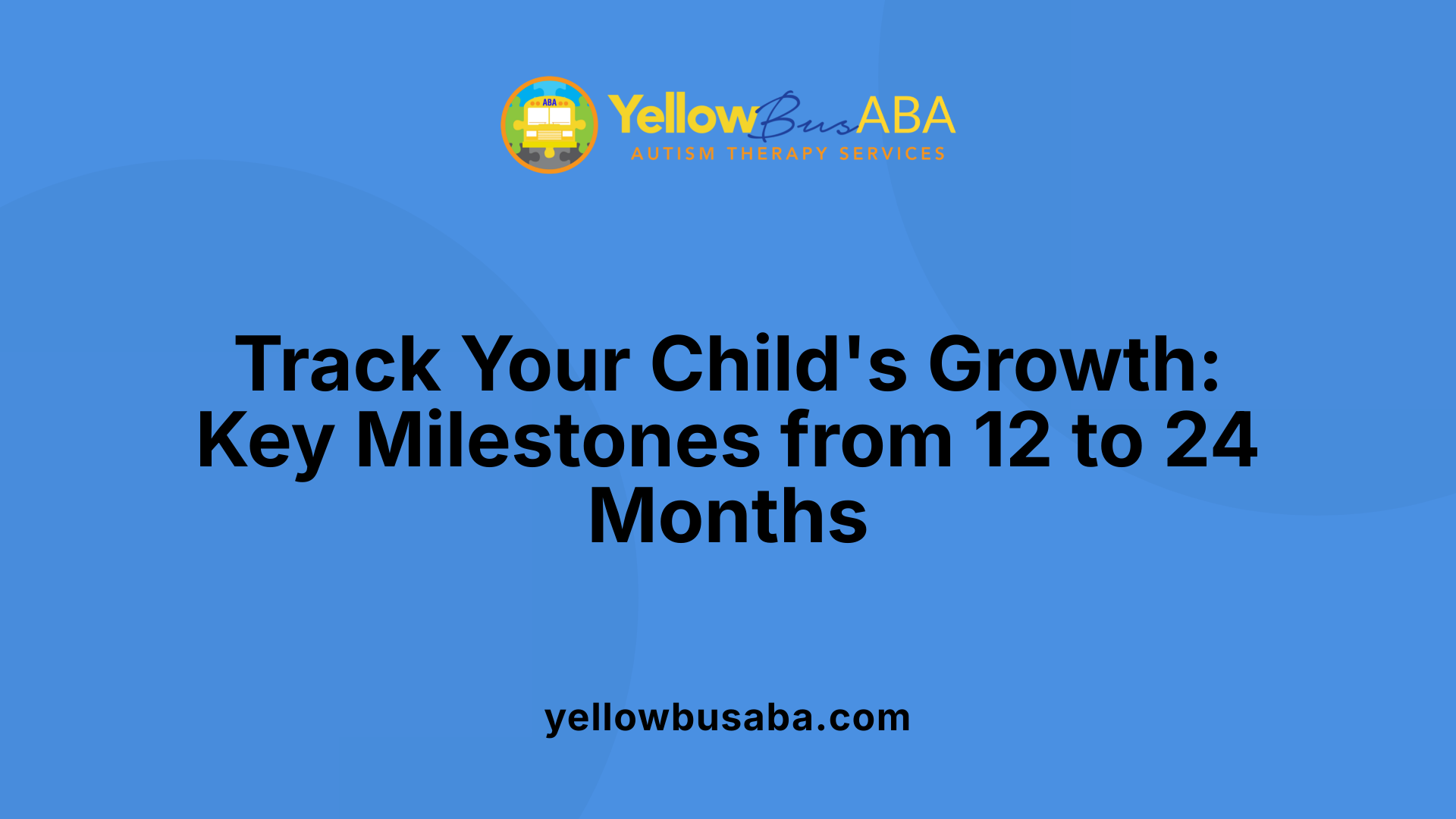How Early Childhood Intervention Enhances Language Development
July 18, 2025
Unlocking Potential: The Power of Early Language Support

The Critical Role of Early Intervention in Language Development
Early childhood intervention is a cornerstone of lifelong cognitive, social, and emotional success. During the first three years of life, children's brains are highly adaptable, making early identification and support essential for optimal development. This article explores how targeted early intervention enhances language skills and sets children on a path toward academic achievement, social competence, and emotional resilience.
Developmental Milestones Between 12-24 Months

What are the typical language development milestones for children aged 12 to 24 months?
Between 12 and 24 months, children go through significant growth in their language skills. They begin to combine words into simple phrases like "more juice" or "daddy go," signaling the start of expressive language. Their vocabulary also expands rapidly during this period, reaching about 100-200 words by the age of two.
Children in this age group typically understand and follow basic commands such as "sit down," "give me the ball," or "wave bye-bye." They can recognize familiar objects, routines, and people, which helps them make sense of their environment. Many begin imitating speech sounds and repeat words they hear frequently, laying the groundwork for clearer speech.
Receptive language skills—this is, understanding language—develop at a faster rate than expressive speech, meaning children usually understand more words than they can say. For example, a child might understand instructions like "bring the book," even if they cannot yet say the word "book."
Supportive activities, including reading books, singing songs, and engaging in playful conversations, significantly help in promoting language growth. These interactions encourage listening, imitation, and the use of new vocabulary.
Parents and caregivers should monitor these milestones and seek professional advice if their child's speech development appears delayed or if they notice limited vocabulary growth or difficulty understanding simple words.
Benefits of Early Intervention for Language and Social-Emotional Skills

What are the key benefits of early childhood intervention for language development, including communication, cognitive, and social-emotional skills?
Early intervention during childhood is crucial for fostering vital areas of development such as speech, cognition, and social-emotional well-being. When children receive support early on, especially if they show signs of developmental delays, they are more likely to develop strong communication skills. This includes the ability to express their needs clearly, ask questions, and understand social cues, all of which are essential for effective social interactions.
In addition, early intervention enhances cognitive abilities like problem-solving, reasoning, and thinking skills. These improvements translate into better academic performance later in school as children are better prepared to follow instructions, participate in classroom activities, and engage with peers.
Furthermore, supporting emotional health is an important aspect. Early intervention helps reduce frustrations caused by communication difficulties, builds self-confidence, and promotes the development of positive relationships. Through targeted strategies such as speech therapy and parent training, children learn to manage emotions, develop resilience, and build social bonds.
In essence, investing in early intervention not only promotes immediate developmental gains but also sets a foundation for long-term success. Children who benefit from early support are more likely to thrive academically, socially, and emotionally, leading to improved life outcomes and overall health.
The Significance of Early Identification and Support

Recognizing signs of language delays
Recognizing early signs of speech and language delays is essential for timely intervention. Some common indicators include limited vocabulary for age, difficulty understanding instructions, little to no babbling by 12 months, challenges in forming sentences by age 3, and unclear speech. Children exhibiting frustration during communication or difficulty socializing with peers may also indicate underlying delays. Early detection allows caregivers and professionals to implement strategies that promote development before these issues become ingrained.
Importance of early diagnosis and intervention
Early diagnosis and support are vital because they capitalize on the brain's heightened plasticity during the first three years of life. During this period, neural circuits related to learning, language, and social behaviors are highly adaptable. Providing targeted therapies, such as speech-language therapy and parent training, can significantly improve communication skills, emotional regulation, and social interaction. Early intervention reduces the risk of long-term academic difficulties, behavioral problems, and social exclusion. It enhances developmental milestones, helping children catch up with their peers and reducing frustration for both children and families.
Role of family and community programs
Family involvement is central to successful early intervention. Training parents and caregivers with practical tools and strategies encourages a language-rich environment at home. Techniques such as engaging in reading, talking during play, and responding positively to initial communication attempts foster language development. Community programs, including home visiting services, preschool interventions, and group therapy sessions like Story Champs, expand access to support. These programs aim to bridge gaps for children from diverse backgrounds, especially those facing socioeconomic challenges, ensuring that every child has the opportunity to develop foundational language skills.
| Aspect | Focus | Additional Details |
|---|---|---|
| Early Signs | Speaking less than peers, difficulty understanding | Observations from parents and teachers help identify issues early |
| Intervention Methods | Speech therapy, parent coaching, classroom support | Customized strategies tailored to each child's needs |
| Impact | Improved communication, social skills, academic readiness | Supports long-term success and well-being |
| Family Role | Engage in daily activities, reinforce strategies | Essential for reinforcing therapy gains |
| Community Resources | Home visiting, preschool programs, group interventions | Address disparities and promote inclusivity |
Effective Techniques and Strategies in Early Language Support

What are some common techniques and strategies used in early childhood intervention to promote language growth?
In early childhood intervention, several approaches are utilized to support and enhance a child's language development. Play-based activities are fundamental, allowing children to learn language concepts naturally through engaging and meaningful interactions. These activities involve integrating vocabulary and sentence structures into games, nurturing spontaneous speech and comprehension.
Modeling language through responsive interactions is another key strategy. Speech-language pathologists and caregivers often use adult-child interactions, such as milieu teaching and shared book reading, to create opportunities for children to imitate and practice new words and sentence structures. Milieu teaching, for instance, involves the adult strategically arranging the environment and responding to the child's initiations to facilitate communication.
Parent coaching is a vital component, where caregivers are trained to implement language strategies during daily routines like play, reading, and mealtime. This approach ensures that language development is embedded into everyday activities, extending therapy beyond clinical settings. Professional development workshops further support these practices, equipping adults with the skills necessary to foster a language-rich environment.
Other evidence-based practices include dialogic reading, which encourages children to ask questions and participate actively during storytime, and repeated vocabulary exposure, which reinforces word meanings and usage. For children with severe delays or disabilities, augmentative and alternative communication systems such as picture exchange or communication devices may be integrated.
Overall, personalized and developmentally appropriate methods, combining both directive and naturalistic techniques, ensure that intervention is responsive to each child's unique needs. These strategies, supported by interdisciplinary collaboration, promote not just language skills but also social interaction, emotional well-being, and academic readiness.
| Technique/Strategy | Primary Focus | Implementation Example | Benefits |
|---|---|---|---|
| Play-based activities | Natural language use | Using toys and games to teach vocabulary | Fun, engaging, encourages spontaneous speech |
| Modeling and responsive interaction | Imitation and response | Adult models a phrase, child repeats | Builds vocabulary and sentence structure |
| Milieu teaching | Environment arrangement | Prompting communication during activities | Increases spontaneous communicative acts |
| Shared book reading | Literacy and social skills | Asking questions about pictures | Enhances comprehension and expressive language |
| Parent coaching | Family involvement | Training parents to use language strategies | Reinforces skills at home, broader reach |
| Augmentative communication | Alternative expression | Using picture boards or devices | Supports children with severe delays |
Research indicates that combining these techniques in a consistent, natural, and developmentally appropriate manner fosters significant improvements in children’s language abilities, setting a strong foundation for overall learning and social interaction.
The Process of Implementing Early Language Support
What is the process involved in early childhood intervention for language development?
Early language support begins with the crucial step of screening and assessment. Qualified professionals, such as speech-language pathologists and developmental specialists, evaluate a child's speech, language, and communication skills. This helps identify any delays or disabilities early, which is vital because the first three years are a period of rapid brain development and high neural plasticity.
Once a delay or concern is identified, the next step involves creating an Individualized Family Service Plan (IFSP). This plan is a collaborative process that includes the child's family, caregivers, and service providers. It specifies tailored goals for improving language and communication skills, outlines the services needed—such as speech therapy, parent training, or behavioral interventions—and determines the most suitable settings, typically in natural environments like the home or community centers.
Interventions are then delivered within these natural contexts, emphasizing activities that are engaging and functional for the child. Techniques such as modeling, play-based activities, and interactive conversations are common, aiming to enhance receptive and expressive language skills.
An essential component of this process is ongoing monitoring and regular review. Children’s progress is tracked through assessments and observations. If goals are not being met, strategies are adjusted to better suit the child's evolving needs. Parents and caregivers are actively involved in applying learned techniques during daily routines like playtime and reading, reinforcing language development even outside of therapy sessions.
This comprehensive approach ensures that interventions are timely, personalized, and effective. Early intervention not only addresses delays but also leverages the brain’s flexibility during early childhood to promote long-term success in communication, social skills, and academic readiness.
What is the process involved in early childhood intervention for language development?
Supporting Parent and Family Involvement in Language Development

How can parents and caregivers support language development in early childhood?
Parents and caregivers play a vital role in fostering early language skills through active engagement and creating rich language environments. One effective way is through interactive activities such as talking about the child's surroundings during daily routines, reading colorful picture books, singing songs, and reciting nursery rhymes. These activities introduce new vocabulary and help children learn about language in enjoyable ways.
Encouraging children to vocalize is also important. When a child makes sounds or tries to speak, caregivers can respond with eye contact and imitation, which reinforces communication efforts. Expanding on the child's words—by adding new information or using complete sentences—helps build more complex language skills.
Incorporating language into everyday routines, like shopping or playtime, provides natural opportunities to introduce new words and ask questions. For example, describing objects at the grocery store or talking about colors during play increases exposure and understanding.
Reinforcing children's attempts at speech without overcorrecting boosts confidence and motivation. Caregivers should model correct language and praise efforts, helping children feel comfortable and eager to communicate.
Using multi-step instructions during activities also supports comprehension and expressive language. Asking children to follow simple commands like “Pick up the toy and put it in the box” encourages understanding and sequencing skills.
Overall, consistent, supportive interaction during daily routines creates a language-rich environment that enhances vocabulary, speech, and social communication, laying a strong foundation for future academic success.
Goals and Long-term Impact of Early Language Intervention
What are the typical goals of early childhood language intervention?
Early childhood language intervention is designed to build a strong foundation for a child's ability to communicate effectively across various settings. Its main objectives include helping children expand their vocabulary, both in different categories and through everyday interactions, so they can express themselves clearly and understand others better.
A significant focus is on developing both receptive language skills—understanding words and sentences—and expressive language skills—using words and sentences to communicate. Interventions often incorporate strategies for improving speech clarity and promoting language comprehension.
Developing narrative skills is also crucial. This involves teaching children how to tell stories, including elements like story grammar, which helps them organize thoughts and relay events coherently. Social communication skills such as turn-taking, initiating conversations, and maintaining dialogs are essential goals that support peer interactions and social relationships.
These goals are tailored to each child's developmental level and often involve specific, measurable targets. Techniques like scaffolding and layered cueing help children gradually acquire new skills. Continuous assessment and collaboration with caregivers ensure that goals remain relevant and achievable, promoting overall communication success.
By focusing on these areas early on, interventions aim not only to improve immediate speech and language abilities but also to lay the groundwork for successful learning, social interactions, and lifelong communication skills.
Development of expressive and receptive language skills
Effective early language programs target improvements in children's ability to understand language (receptive skills) and to use language to express ideas (expressive skills). Progress in these areas supports better participation in classroom activities and social settings, critical for academic and personal growth.
Narrative and social communication skills
Teaching children how to craft narratives helps them organize their thoughts and communicate stories with clarity, fostering independence and confidence. Social communication skills include understanding social cues, turn-taking, and engaging in conversations—all vital for building relationships and functioning well in group settings.
Preparation for school success and lifelong learning
Early language intervention primes children for academic success, particularly in reading and writing, which are rooted in strong oral language skills. It also cultivates essential life skills, such as problem-solving, emotional regulation, and self-advocacy, setting them up for lifelong learning and achievement.
Long-term Benefits and Lifelong Success
How does early childhood intervention contribute to lifelong developmental success?
Early childhood intervention is a vital factor in shaping a child's future, especially concerning their academic, social, and emotional well-being. By providing targeted support during the first years of life, when the brain exhibits maximum plasticity, these programs help children establish essential skills that serve as a foundation for later development.
Interventions such as speech therapy and parent-implemented strategies not only address immediate communication delays but also promote phonological, vocabulary, and grammatical skills critical for literacy and learning. For example, improving expressive and receptive language early on prepares children for successful reading and writing in school.
Beyond academics, early intervention fosters social skills including cooperation, turn-taking, and understanding social cues. These abilities are crucial for forming friendships and participating effectively in group settings. Emotional regulation skills are also developed through interventions that focus on behavioral management and relationship building, reducing feelings of frustration, anxiety, and isolation.
Research shows that children who receive early support tend to perform better academically, are more likely to graduate from high school, and have higher employment prospects as adults. They often demonstrate greater independence and self-management, which further enhances their capacity for lifelong learning and adaptation.
Moreover, early intervention helps to mitigate the adverse effects of health disparities, economic disadvantages, and adverse childhood experiences. By promoting resilience and providing equitable access to developmental resources, these programs contribute to reducing disparities in education and health outcomes.
In summary, investing in early intervention not only addresses immediate developmental challenges but also builds a robust foundation for lifelong success. It enhances cognitive, emotional, and social skills, leading to higher rates of employment, improved mental health, and greater societal engagement in adulthood.
Building a Foundation for Lifelong Success
Investing in early childhood intervention, especially for speech and language skills, yields profound benefits extending well into adulthood. Early support not only helps children meet their developmental milestones but also fosters confidence, resilience, and the ability to succeed academically and socially. By leveraging neural plasticity and involving families actively, these programs lay a robust foundation for a lifetime of meaningful communication, learning, and personal growth.
References
- Benefits of Early Intervention in Speech Pathology
- The Longitudinal Effects of Early Language Intervention on ...
- The Importance Of Early Intervention In Speech Therapy: A Guide ...
- Why Early Intervention? A Great Opportunity for Children and Families
- The Importance of Early Intervention for Children with Speech and ...
- The Importance Of Early Intervention Services For Language ...
- Early Family Intervention in Children with Language Delay
- The Importance of Early Intervention | Reading Rockets
- Effects in language development of young children with language ...
- Early Language Intervention


.jpg)



